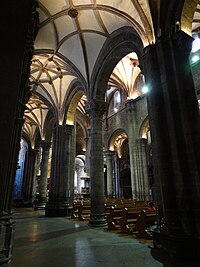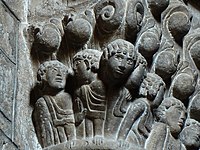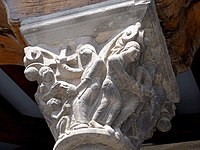Jaca Cathedral
The Cathedral of Jaca , consecrated to Peter , is the cathedral church of the Diocese of Jaca in the Spanish city of Jaca , in the province of Huesca in Aragon . It is the oldest Romanesque cathedral in Spain.
Geographical location
The cathedral is built tightly on the western edge of the old town of Jaca. The two outer entrances lead from the Plaza San Pedro - a monastery of the same name used to be located here - from the west and from the Plaza de la Catedral from the south into the church.
history
Jaca became a royal residence in 1054 and a bishopric in 1076/77. King Sancho I of Aragón pursued a religious and political rapprochement with the Holy See . In doing so, he distinguished himself from his ruling cousins in León , who sought to enforce a claim to rule over all Spanish empires. Connected with this was the turn to the Gregorian reforms and the Roman rite instead of the traditional Mozarabic rite . On March 22, 1071, the Roman liturgy was introduced in Aragón in the presence of the king.
In return, the king received political support from the Pope, including the establishment and control of the diocese of Jaca . According to an unsecured tradition, the choir and transept are said to have been consecrated as early as 1063. According to another source, construction should not have started until 1085. Although the data for the construction cannot be precisely defined, two phases can be distinguished:
- The first is dated to around 1094, which corresponds to the reign of Sancho I and the term of office of Bishop García Ramírez of Aragón , a close relative of the king. The building sculpture of this phase together with San Martín in Frómista , the castle chapel Santa María in Castillo de Loarre and the first construction phase of the cathedral of Santiago de Compostela represent the first steps of independent Spanish Romanesque.
- The second phase is set in the period from 1104 to 1130, which corresponds to the rule of Alfonso I and Esteban de Huesca as bishops.
After these intensive construction phases of the Romanesque cathedral, there were then individual additions. A chapter house was added to the north in the Romanesque period . Shortly after 1520 the side aisles were vaulted in a late Gothic style. A vault in the Romanesque period was already planned. However, it is unclear whether it was actually carried out. In 1598 the central nave was (new?) Vaulted and larger windows were broken in. The chapels for St. Sebastian , St. Augustine and St. Anna were given new ceilings during the Renaissance . In 1572 two chapels were added - also in the Renaissance style - for the Archangel Michael and the Holy Trinity .
In the 17th century a new high altar was created and the cloister was rebuilt in baroque style. It is located on the north side of the cathedral and is now part of the Diocesan Museum. In the 17th century, the chapel of St. Orosia , the city patroness of Jaca, the most outstanding baroque component in the church, was added. In 1791 the Romanesque apse of the central nave was replaced by a new one. The architect was Manuel Bayeu , Francisco de Goya's brother-in-law , who also painted the new choir in 1792.
Building
Jaca Cathedral is one of the oldest Romanesque architecture churches in Spain. It is a three-aisled basilica that has retained this basic type despite all structural changes over the centuries. The transept does not protrude beyond the aisles. There is a crossing tower above the crossing
Exterior

|

|
|
|
View from the north aisle
|
Main apse, by Manuel Bayeu (1791)
|

|

|
|
|
Capital: King David makes music
|
Capital: group of figures
|

|

|
|
|
Capital of the south portal
|
Capital: Sacrifice of Isaac
|
The two entrances to the west and south are each provided with a portico . The Romanesque west portico is formed by two large vaults that extend the central nave outwards by two bays . Here is a tympanum that - unusual - shows a Christ monogram . It could be the oldest surviving Romanesque tympanum at all. The Christ monogram stands between two lions, which is also interpreted as a symbol of the Aragonese monarchy. According to another interpretation, the lions represent Christ, an image from the Apocalypse . The (heraldic) right lion stands with his mouth closed over a man who is catching a snake. The (heraldic) left lion, on the other hand, shows its teeth and steps on a bear and a basilisk . There are also three inscriptions in Latin . The inscription that runs around the chrismon reads:
"HAC IN SCULPTURA LECTOR SIC NOSCERE CURA / P. PATER A. GENITUS DUPLEX EST SPIRITUS ALMUS / SUNT TRES IURE QUIDEM DOMINUS SUNT UNUS IN IDEM"
The inscription on the (heraldic) right lion reads:
"PACERE STERNENTI / LEO SCIT / CHRISTUMQUE PETENTI"
The inscription on the (heraldic) lion on the left reads:
"IMPERIUM MORTIS / CONCULCANS ET LEO FORTIS"
The southern portico dates from the 16th century and also protects the Romanesque sculptures on the southern portal.
Of the apses of the Romanesque choir , only those of the side aisles are preserved. At the end of the 17th century, the Romanesque apse in the central nave was replaced by a new one. The apse of the north aisle is no longer recognizable from the outside after a house has been added. Only the southern apse still shows the characteristic elements of the Romanesque architecture of the Way of St. James .
The bell tower dates from the 16th century and dominates the western porch.
Inside
A characteristic element of the interior is the alternation of columns and beam pillars , the main and side vessels separate. The naves end in the three semicircular apses. The cathedral has a total of twelve chapels .
The apse of the central nave is longer, but a structural addition from the 18th century after the medieval predecessor had moisture problems. In 1919 the organ was moved to the choir.
Furnishing
The numerous preserved Romanesque capitals , corbels and metopes are made by at least two different artists or workshops and mostly show scenic representations. The walls and plinth, on the other hand, are more geometrically decorated. The handling of naked figures is strongly antiquated for the early works. The shapes of the corbels are closely related to the architectural sculpture in San Martín in Frómista. The later, ascribed to a master of Jaca , have given up the antiqueizing moment.
The reredos of the main altar were painted by Juan de la Abadía at the end of the 15th century.
monument
The cathedral is a Spanish cultural monument ( Bien de Interés Cultural ). It is listed in the register of monuments under the number RI-51-0000627.
Worth knowing
- The relics of Voto and Felix, founders of the Monastery of San Juan de la Peña , are venerated in the Cathedral of Jaca.
- On the south door of the cathedral is the sculpted scale for a Vara Jaquesa , a medieval length of 77.2 cm. The yardstick served as a reference for the neighboring market, but the unit of length was used throughout Aragón.
- A book cover with carved ivory - crucifix from the period before 1085 was originally part of the equipment of the cathedral and is now in the Metropolitan Museum of Art in New York .
literature
- Dietrich Höllhuber and Werner Schäfke : The Spanish Way of St. James. History and art on the way to Santiago de Compostela . DuMont, Cologne 1999, ISBN 3-7701-4862-2 .
- Pedro de Palol et al. Max Hirmer: Spain. Art of the early Middle Ages from the Visigoth Empire to the end of the Romanesque period . Hirmer, Munich 1965.
- Kingsley Porter: Romanesque Sculpture of the Pilgrimage Roads . 3 volumes. Hacker Arts Books, New York, reprinted 1969.
- Werner Schäfke: Northwest Spain. Landscape, history and art on the way to Santiago de Compostela . DuMont, Cologne 1987, ISBN 3-7701-1589-9 .
- Pierre Tisné et al: Spain. Pictorial Atlas of Spanish Art . DuMont Schauberg, Cologne 1968, ISBN 3-7701-4461-9 .
Web links
- La Catedral de Jaca ( Spanish )
- Architectural drawings and plans for the cathedral
- Cathedral on Románico Aragonés (Spanish and English )
- El Románico y Prerrómanico en Huesca (Spanish)
Individual evidence
- ↑ Tisné: Spain , p.
- ^ Palol: Spain , p. 72.
- ↑ Höllhuber: The Spanish Way of St. James , p. 59.
- ↑ See Damian J. Smith: Innocent III and the Crown of Aragon: The Limits of Papal Authority . Ashgate Publishing, Ltd., 2004, p. 48.
- ^ Schäfke: Nordwest-Spanien , p. 32; Tisné: Spain , p. 400; Palol: Spain , p. 72.
- ↑ Höllhuber: The Spanish Way of St. James , p. 59.
- ↑ The will of Doña Sancha , a daughter of King Ramiro I of Aragón from 1094 contains donations for the (further) construction of the cathedral (Palol: Spain , p. 72).
- ↑ Höllhuber: The Spanish Way of St. James , p.
- ↑ See: Palol: Spanien , p. 72.
- ↑ Höllhuber: The Spanish Way of St. James , p. 61.
- ↑ Tisné: Spain , S. 400th
- ↑ Höllhuber: The Spanish Way of St. James , p. 61.
- ↑ Höllhuber: The Spanish Way of St. James , p. 61.
- ↑ Tisné: Spain , S. 402nd
- ↑ Schäfke: Northwest Spain , p. 32.
- ↑ Höllhuber: The Spanish Way of St. James , p. 61.
- ^ Palol: Spain , p. 73.
- ^ Palol: Spain , p. 72.
- ^ Palol: Spain , p. 73.
- ↑ Tisné: Spain , S. 400th
- ↑ See: Porter: Romanesque Sculpture. Volume 5 [2], panels 520-526.
- ↑ Höllhuber: The Spanish Way of St. James. P. 61.
- ↑ Register entry as a cultural monument .
- ↑ José Maria Foixench Naval: Monastère Royal de San Juan de la Peña . Editorial Kapitel, o. O., [before 2019]. ISBN 978-84-937005-3-9 , pp. 30f.
- ↑ See: Porter: Romanesque Sculpture , Volume 1, pp. 37, 41, 48, 52, Fig .: Volume 2 [5], plate 519.
Coordinates: 42 ° 34 ′ 14.7 " N , 0 ° 32 ′ 56.5" W.



